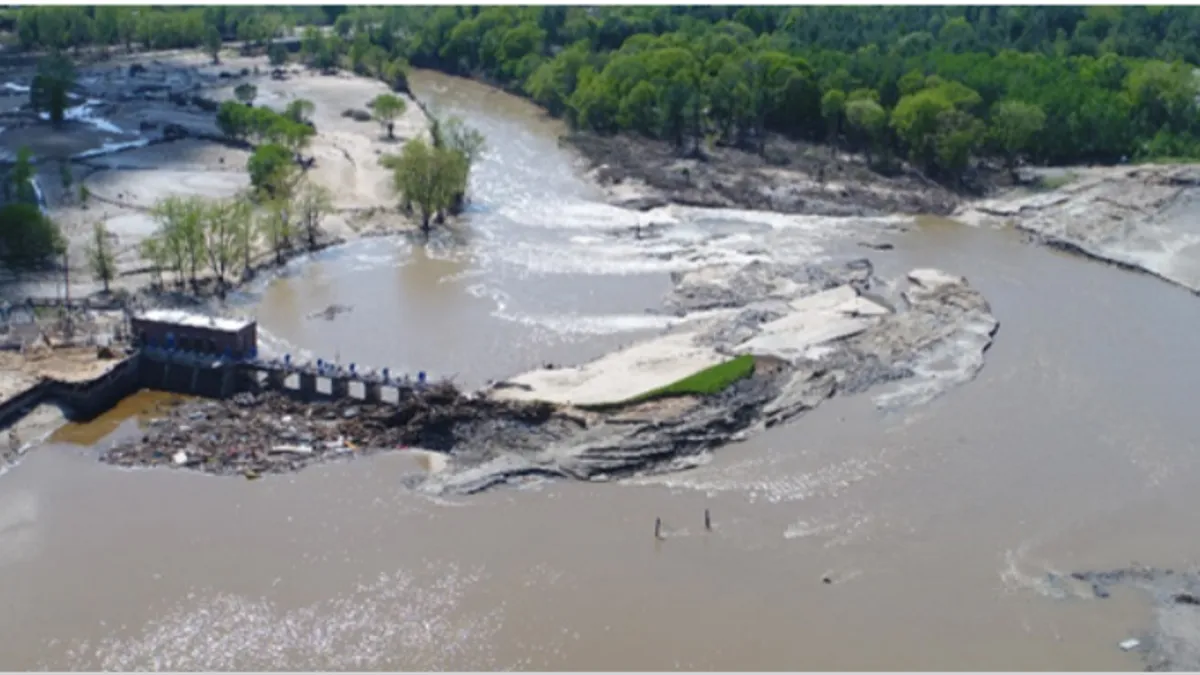Dive brief:
- Many problems contributed to the “foreseeable and preventable” Edenville and Sanford dam failures in central Michigan in 2020, according to the final forensic report investigating the incident. The collapse forced the evacuation of 10,000 people in central Michigan and caused $175 million in damage to downstream homes.
- A key embankment was compacted improperly when the dams were built in the 1920s, setting them up to fail a century later, the Federal Energy Regulatory Commission report found, and inspections failed to raise problems with it. In addition, the private owners did not properly maintain the structures and may have lacked the financial resources to do so.
- There are more than 15,000 high hazard dams owned by entities other than the federal government, according to a March 2022 Association of State Dam Safety Officials report. That number of frail, high hazard dams is growing, recent AP News analysis shows, and climate change is exacerbating extreme weather conditions which could increasingly push them over the edge.
Dive insight:
In May 2020 three days of rainfall created unusual levels of runoff, which filled the Wixom Lake reservoir above the Edenville Dam to an all-time high, the report found. This waterlogged the dam’s embankment and caused it to collapse, which then overwhelmed the downstream Sanford Dam. Experts previously assumed that only an earthquake could make a dam embankment liquify in this way.
The final report delves into human factors not included in FERC’s interim report. Inspectors failed to identify loose sand in the embankment, and made a series of faulty assumptions when calculating the capacity of the Edenville spillway, which is supposed to prevent flooding. That led them to misunderstand the true risk of high water levels in the reservoir. The flood came a year and a half after FERC terminated the owners’ license to generate power at the Edenville Dam, after they failed for over a decade to fix the spillways.
“As is the case with almost all civil engineering structure failures that have occurred, the Edenville and Sanford dam failures cannot be attributed to a single factor. Rather, they’re a result of a combination of factors, some physical and some human,” said John France, one of the investigators, in a press conference about the report on May 5. “Human actions or inactions were contributors, and had those been different, these failures would not have occured.”
Nevada architect Lee Mueller and his cousin Michel d’Avenas created the company Boyce Hydro to purchase the Edenville, Sanford, and two other central Michigan dams as tax shelters in 2006, Bridge Michigan reported, and they owned them at the time of collapse. These private owners said they did not make enough revenue to allow them to get financing to build the spillways.
No one died in the flood, even though the investigators found the emergency action plan guidance to be “inconsistent and contradictory.” The Midland County Emergency Manager decided to evacuate residents earlier than the guidance suggested. Her decision may have saved lives. Emergency action plans need to have consistent guidance to help prevent future tragedy, the authors said, and also need to be flexible enough to allow decision makers to exercise their own judgement.
Concerns remain
Lack of funding raises concerns for dams. Almost 89,000 dams are owned by individuals, companies, community associations, state and local governments and others besides the federal government. The American Society of Civil Engineers gave dams a D in its latest infrastructure report card. While the country builds a lot of infrastructure, it is not very good about maintaining it, France said.
The federal infrastructure act does contain about $3 billion for dam projects, a fraction of the $76 billion needed to fix non-federally owned dams, according to the ASDSO report.
“[Dam failures are] part of the larger infrastructure problem that we have in this country,” France said. “[The infrastructure act is] good, it’s a positive direction, but it really is a small part of what’s needed to remedy our infrastructure deficits right now.”
Lessons learned
The report authors suggest low-interest loans and grant programs from all levels of government to help owners shore up dams. They also said more public private partnerships could help spread out responsibility, and counties and local residents who benefit from the dam should also chip in.
The authors noted that 90% of U.S. dams are regulated by state authorities, and said states should periodically conduct a comprehensive, independent review of their dams. From an engineering and risk calculation standpoint, dam experts must plan for the fact that static liquefaction, or sudden loss of soil strength, is a possible point of failure even in absence of an earthquake.
FERC didn’t have much power to compel owners to make changes, like building larger spillways or ordering the lake drained. The authors said they should have the authority to order breach of a dam if they think public safety is at risk, not only in the case of an emergency.
“The [independent forensic team] found that the failure cannot reasonably be attributed to any one individual, group, or organization,” the report said. “Instead, it was the overall system for financing, designing, constructing, operating, evaluating, and upgrading the four dams, involving many parties during the nearly 100 years of project history, which fell short in ensuring a safe dam at the Edenville site.”













